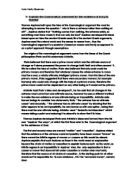Explain and illustrate the Illusion and the time-lag arguments for the existence of sense data (15)
Explain and illustrate the Illusion and the time-lag arguments for the existence of sense data (15)
The time-lag argument rests on four main premises. The first premise is that we cannot perceive physical objects or events unless light is reflected or emitted from them to our visual system. The second is that light travels at a finite velocity, and so there is always some time interval between the reflection or emission of light from a physical object or event and the light’s reaching our eyes. In the case of nearby objects or events, the time interval may be minute. But in the case of a distant star, the time interval may be so considerable that, by the time the light reaches our eyes, the star may no longer exist. The third premise is that if something no longer exists, we cannot now perceive it, let alone directly perceive it. And so, assuming the distant star no longer exists, we cannot directly perceive it when its light reaches our eyes. But since we are perceiving something, the object of the (direct) perception must be something other than the distant star. The fourth premise is that though time lags are most significant in cases of distant objects such as stars, any time lag, however minute, between physical objects or events and our perception of them is incompatible with Direct Realism, for given the time lag, we cannot directly perceive physical objects and events as they presently are at the time of our perception. Since we perceive something, the object of (direct) perception must be something other than physical objects or events. The conclusion of the time-lag argument would be that Direct Realism is false. We do not directly perceive physical objects and events, and as we are still perceiving these distant stars, and other such objects, there must be a mediator, which therefore proves the existence of sense data.








